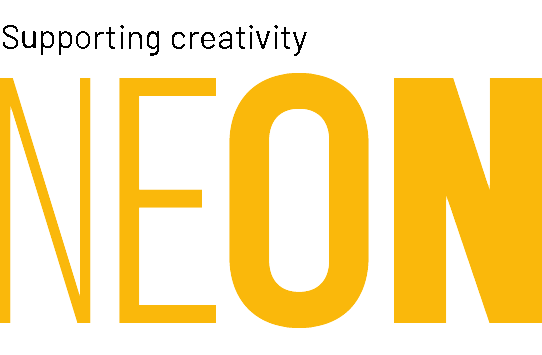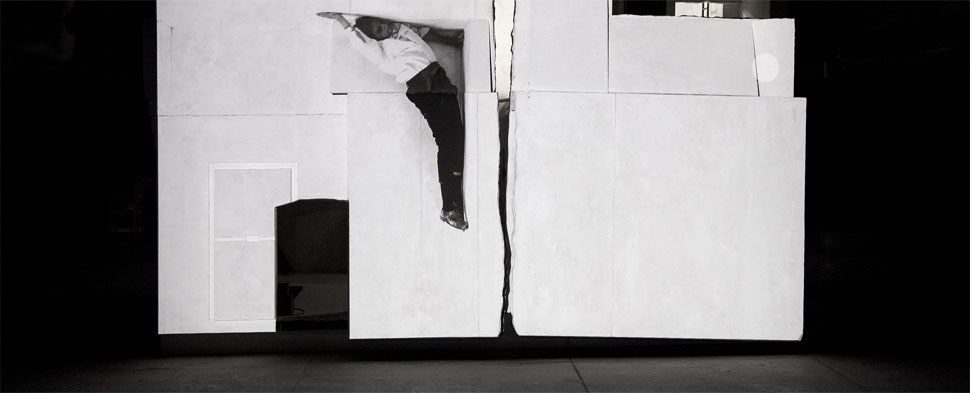concept, direction, set design Dimitris Kourtakis
dramaturgy Dimitris Kourtakis, Eleni Papazoglou, Anastasia Tzellou
video Jérémie Bernaert
music Dimitris Kamarotos
lighting design Scott Bolman
artistic collaboration Efi Birba
assistant to the director Natasha Triantafylli
design assistant Vassia Liri
video engineer Nikos Iliopoulos
lighting design assistant Evina Vassilakopoulou
production manager Dinos Nikolaou
set construction Lazaridis Scenic Studio
plaster design construction Freddy Gizas
performance Aris Servetalis
lenght 1 hour and 10′
national première
with English subtitles
The performance Failing to Levitate in My Studio is realised with the financial support of the Greek Ministry of Culture and Sports

co-producers


We advise the public to arrive half an hour before the start of the performance
An extraordinary performance that caused a sensation when it was debuted at the Athens and Epidaurus Festival. Inspired by texts by Samuel Beckett exploring Man’s inability to define a Self, the director Dimitris Kourtakis has created a multimedia performance in collaboration with a team of internationally-acclaimed artists. The interpretation of Aris Servetalis is exceptional; considered one of the most talented Greek film and theatre actors of his generation, he collaborates with masters including Dimitris Papaioannou and Yorgos Lanthimos.
Shut up in his studio and detached from the world, a performer uses his body as material and as an experimental field, until the irreversible dissolution of the Self and the exhausting of words in a space which he constantly and vainly attempts to inhabit – a non-place.
The stage space: an enclosed two-storey structure inside which the performer films himself and the space like another Krapp. The internal place and self are rendered, in a process of inexhaustible reflection, as images which are filmed and projected in real time onto the structure’s outer surfaces. The projection renders both place and self intangible – spectral.
The proliferation of these images render the fundamental elements of the Beckettian universe theatrically present: person and space/body and time. Until they are negated.
Watching the character’s actions through its openings and the projections onto the walls, the viewers are invited to partake of a clandestine and ultimately illusory viewing. For it soon becomes clear they share the same condition: enclosed in a second antechamber, a vainly-waiting room of their own, they become viewing subjects and viewed objects of their own spectres – and thus of an absence.
Representing absence: the production’s materials
The production is based on prose pieces by Samuel Beckett and engages with visual artists like Bruce Nauman, Vito Acconci, Terry Fox, Absalon, Joseph Beuys, Gordon Matta-Clark, Rachel Whiteread and others – artists who, sometimes deliberately, sometimes unconsciously, reference the Beckettian universe, exploring through their work the limits of the self, of space and of language.
The body of absence: between the Ego and the non-Ego
The person waiting. Waiting for an interlocutor – the Other who will allow him to be seen, to be addressed, to speak. But interlocutors always turn out to be deceitful: all there is is the image of the self – and that is ultimately deceitful, absent, too. His discourse is shattered so it can mimic silence; the inwardness of the monologue, rather than revealing a self, sheds light on its absence; the
addressing of the Other, to the extent that s/he exists, rather than serving some form of communication, exposes its impossibility and insubstantiality; the narrative flow grows confused: before, now, and after are crushed together in the same duration. The way in which the person confirms that he “is”, or that he “isn’t” but “was” or “became” resounds less as a triumphal awareness and more as a desperate attempt to retain some minimal link between the “I” that is speaking and his body.
In the meantime: The person keeps moving on. His life is composed of memories; his now is a series of unremarkable happenings, like:
“…sounds of the body on its way, of the bare feet on the wet ground, of the laboured breathing, of the body striking against the walls or squeezing through the narrows…”.
His land: a “ruinstrewn land”, of a piece with his inner, entirely insentient world.
His words: a manifesto for the dissolution of speech, in which language can no longer either name or tame.
His place: a landscape of intransigent stasis. His movements are jerky and, by necessity, his thoughts are, too. He becomes a skull where dust is shovelled, then shovelled again, for all eternity.
From the press:
«It was clear from the start that Kourtakis hadn’t set his sights on simply referencing Beckett, as so many others have done; what he wanted was to convey a highly specific, solitary and personal
condition for an engaged audience to bear witness to. Most of those who saw Kourtakis’ production will talk about it and their descriptions will bring it back to life over and over again. But I want to take it one step further. Because with an undertaking like this one, Kourtakis and Servetalis, Kafka and Beckett, ultimately provide the starting point, nothing more. Their levitator points towards a deep and inner train of thought about man and his fate. Which is why Kourtakis’ performance illuminates with its darkness and speaks from within its silence. Behold the great Mystery: when Beckett uttered his famous “Try again, fail again, fail better”, we know he meant the condition of human irony, something like “if you try again, you’ll fail again”…
And yet, what do we take away? His courage. What’s important isn’t that we failed. What’s important is that we will try again. Out of the failure to levitate, we recall flight». – Gregory Ioannides,
Efimerida ton Syntakton, 24 luglio 2017
«With unrivalled sensitivity, taking hesitant steps and perilous levitations, Aris Servetalis, boxed up in a derelict, two-storey construction with a biblical crack running vertically down its middle,
delivers an aphoristic discourse, an “internal” monologue, studded with fragments from Beckett’s prose. Sitting on either side of the structure, the audience watch his image – filmed live either by the video artist, Jérémie Bernaert, or by the performer, capturing himself on film like another Krapp – projected onto the walls. […] Dimitris Kourtakis’ sensational production takes root deep in the Beckettian universe». Eleni Petasi, clickatlife.gr, 1 agosto 2017
Dimitris Kourtakis
Born in Athens in 1972. Following studies in Music (Ecole Normale de Musique de Paris), he direct for the theater, staging Roland Schimmelpfennig’s Arabian Night for Notos Theatre and Kafeneion (a synthesis of ancient texts) for the Athens Festival. He studied under Krystian Lupa (Lausanne, Strasbourg) and has collaborated with Dimiter Gotscheff – taking charge of the
chorus in the Persians (Epidaurus Festival) – and with Roula Pateraki. He has also written music for theatre and dance productions, and has collaborated inter alia with the Dance Theatre on the National Theater of Northern Greece, the Heidelberg Theatre, the International Theatre Institute (ITI), and the Volksbühne, Berlin. Works of his have been performed at international festivals
including the Lyon Dance Biennale, France, and in Brazil, Singapore, Germany, Italy, Portugal and Israel. He lives and works in Paris and Athens.
×


